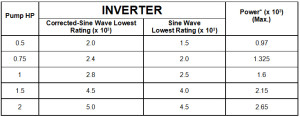Solar Water Pump System: key components
Solar Water Pump Pipes: Pipe Sizing Chart
Solar Water Pump Inverter: correct sizing essentials
Solar Tracking Water Pump Systems: optimal power yield
 Solar water pump inverter sizing table[/caption]The standard average running power is usually between 10-20% with typically about 10% of power losses in the inverter. The modified sine-wave inverter will take the losses to 15% because the motor efficiency is affected negatively.
Solar water pump inverter sizing table[/caption]The standard average running power is usually between 10-20% with typically about 10% of power losses in the inverter. The modified sine-wave inverter will take the losses to 15% because the motor efficiency is affected negatively.